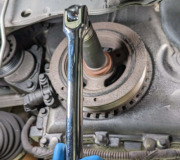The gear selected doesn't matter, even park. The engine just drives an oil pump in the transmission. There's no direct mechanical link to the transmission. What you could have is a flex plate bolt that walked out and is catching on the webbing at the back of the block.
"I know that the cam will rotate once per three turns of the crank, will I then have to rotate the cam three times?"
The crank turns twice per camshaft revolution, not three times. Also, 10 degrees BTC is for all practical purposes right at TDC. The piston is barely going to move a fuzz those last ten degrees. If a piston were to hit an open valve, it won't even get close to ten degrees.
The clue that a piston is hitting a valve would be found by turning the crank the other way and finding it would stop the same distance from TDC. That's fine for a single cylinder, but when four are involved the crank will only turn backward until a piston in a different cylinder hits a valve. If you can turn the crank almost a complete revolution backward before it locks up again, I'd look closer at the flex plate bolts. Of course, depending on the orientation of the cam, there is only going to be one intake valve open and one exhaust valve open so maybe you WOULD be able to turn the crank almost all the way.
I will take your word that this isn't an interference engine, (I can't find any reference to the contrary), but to double-check, when the crank locks up, turn it backward just a little, then rotate the cam, ... Oh, ... A good quarter turn, then see if the crank locks up in exactly the same place. If it does, we'll know it's not hitting a valve because the valves will have moved.
The only other thing I can think of is if the crankshaft thrust bearing is worn allowing the crank to move forward or backward a little. On some engines a counterweight on the crank will hit the webbing inside the block below the cylinders. That typically happens with manual transmission from the force of pushing on the clutch which pushes the crank into that thrust bearing and causes wear. I did see it happen once on a Ford pickup from the torque converter "ballooning" when pulling a car hauler up a hill. The added fluid pressure caused the torque converter to grow and push the crankshaft forward until it hit the webbing in the block. Of course the engine had to be running and under load for that to occur.
Some engines use a balance shaft to dampen vibration. They can be driven by the timing belt as on Chryslers but some are driven by gears in a housing next to the middle of the crank. If you have that design, it doesn't sound like you had it apart, but incorrect timing could cause that shaft to hit the crank.
As a last resort, you may have to start unbolting things until you find what the crank is hitting. Think about a crankshaft position sensor that is adjusted in too far, (many are not adjustable), or you could loosen the camshaft bolts to let it up a little. If that works, there has to be a valve hitting a piston for some reason.
My last suggestion involves the key for the vibration damper. Most imports use a rounded woodruff key between the snout of the crank and the damper. Check if that key slid back when you slid the damper on. It could be catching on a reinforcement web on the oil pump housing. That might make it almost all the way around too if you turn the crank backward. If there is only one web for it to hit, you'll get almost a complete revolution out of the crank.
Saturday, April 3rd, 2021 AT 12:14 PM



